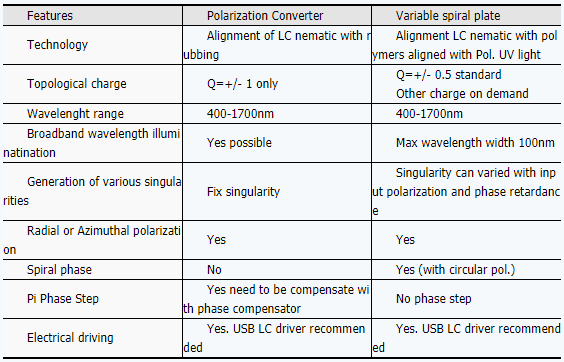
产品描述
Variable spiral plate (VSP) for vortex beam generation
The variable spiral plate (VSP) is a passive liquid crystal optical element that is capable to modify the spatial distribution of the polarization of a homogenous polarized beam (as for example a simple Gaussian laser beam). The VSP is perfectly transparent optical element without losses (apart of the absorption losses of the material), scattering or diffracted light. The conversion from homogenous linear polarized beam to for example radial, azimuthal (or also lemon, spiral or star distribution) can simply be obtained by placing the VSP in the optical path of your laser beam. The different output polarization patterns can be obtained by simply changing the bias applied on the VSP.
Capable to generate many different circular symmetric and continuous polarization distributions by simply changing the bias or input polarization
One element works for all wavelength from 400 to 1500nm
Works for all types of laser also femto-second pulsed lasers
Capable to generate Orbital momentum and helical beams
Capable to generate radial & azimuthal polarization distribution
No loss, No scattering, No diffraction, No segments
Orbital momentum or helical wavefront generation- Spiral phase plate (SPP)
One interesting application of the VSP is the transformation of a planar wavefront with circular (left or right) polarization into a beam with an optical vortex (with an undefined phase in the center of the beam). Such a beam carries an orbital momentum (OAM) and has a helical wavefront as shown in the picture below. The retardation of the q-plate is controlled by an AC bias and can be adjusted to any wanted value between 50-1500nm. As an additional feature the orbital momentum can switched on and off (within 100ms) simply by changing the bias on the q plate.
Radial and atimuthal Polarization
As the arcoptix radial polarization converter product (link) the VSP (with topology q = 0.5) is capable to transform a linear input polarization into a radial or an azimuthal polarization (depending of the input polarization). The same q-plate can be adapted to any wavelength by simply adjusting an AC voltage (0-5V) that is applied on the VSP.
Spiral Phase
The Variable Spiral Plate can produce from a simple gaussian create a beam with a spiral phase. To proove this, we a well-known Mac-Zehnder interferometer setup coupled to a ccd camera to record the interference pattern at the output of the interferometer. By tilting the two beams of the interferometer we obtain regular interference fringes (as shown in picture) and by introducing a spiral plate (with half wave retardation) we obtain a phase dislocation (pitchfork hologram). Again if the VSP retardation is tuned (via a electric bias) to full wave retardation the dislocation disapear as in pictures below...
Notice that the spiral plate is similar to our radial polarization converter product. The principal difference between this product is that with the spiral plate one can obtain either a spiral or a radial polarization and with the polarization converter one obtains always the radial polarization and the spiral phase at the same time. The differences between the spiral plate and the arcoptix polarization converter are summarised in the table below.
By looking at the comparaison in the table it seems clear that the VSP has many advantages compared to the polarization converter. Also the VSP does not have the PI phase step in the middle of the aperture which makes the device simpler to adjust and beam quality will be better. It is also important to note that polarization is a proven device that has already been used by many scientists with full satisfaction. The VSP is a new product that does not have references for the moment.
技术规格
